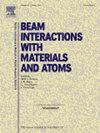In-situ measurement of radiation driven back-conversion from para to ortho liquid hydrogen state in cold moderators at J-PARC
IF 1.4
3区 物理与天体物理
Q3 INSTRUMENTS & INSTRUMENTATION
Nuclear Instruments & Methods in Physics Research Section B-beam Interactions With Materials and Atoms
Pub Date : 2024-09-26
DOI:10.1016/j.nimb.2024.165534
引用次数: 0
Abstract
At Japanese Spallation Neutron Source in J-PARC, the para-hydrogen fraction was measured by using Raman spectroscopy in-situ for an integrated beam power of 9.4 MW h at 1MW operation, to evaluate the functionality of the ferric oxyhydroxide catalyst. This result showed that full functionality of the catalyst was retained up to the 1 MW operation. We attempted to study the effect of neutron scattering driven para to ortho-hydrogen back-conversion rate in the absence of the catalyst effect with a bypass line without catalyst. The measured increase of ortho-hydrogen fraction was 0.44% for an integrated beam power of 2.4 MW h at 500 kW operation, which was attributed not only to neutron collisions in cold moderators but also to the high ortho-hydrogen fraction of initially static liquid hydrogen in the bypass line and passive exudation of quasi-static hydrogen in the catalyst vessel to the main loop.
在 J-PARC 冷缓和剂中现场测量辐射驱动的对位液氢向正液氢的反向转换
在日本 J-PARC 的日本溅射中子源,使用拉曼光谱对 1MW 运行时 9.4 MW h 的综合束流功率下的对氢部分进行了现场测量,以评估氢氧化铁催化剂的功能。结果表明,催化剂的全部功能一直保持到 1 兆瓦运行。我们尝试使用一条不含催化剂的旁路管线,研究在没有催化剂效应的情况下,中子散射驱动的副氢与正氢反向转化率的影响。在 500 kW 运行条件下,综合束流功率为 2.4 MW h 时,测得的正氢比例增加了 0.44%,这不仅归因于冷慢化剂中的中子碰撞,还归因于旁路管线中初始静态液氢的高正氢比例以及催化剂容器中准静态氢向主回路的被动渗出。
本文章由计算机程序翻译,如有差异,请以英文原文为准。
求助全文
约1分钟内获得全文
求助全文
来源期刊
CiteScore
2.80
自引率
7.70%
发文量
231
审稿时长
1.9 months
期刊介绍:
Section B of Nuclear Instruments and Methods in Physics Research covers all aspects of the interaction of energetic beams with atoms, molecules and aggregate forms of matter. This includes ion beam analysis and ion beam modification of materials as well as basic data of importance for these studies. Topics of general interest include: atomic collisions in solids, particle channelling, all aspects of collision cascades, the modification of materials by energetic beams, ion implantation, irradiation - induced changes in materials, the physics and chemistry of beam interactions and the analysis of materials by all forms of energetic radiation. Modification by ion, laser and electron beams for the study of electronic materials, metals, ceramics, insulators, polymers and other important and new materials systems are included. Related studies, such as the application of ion beam analysis to biological, archaeological and geological samples as well as applications to solve problems in planetary science are also welcome. Energetic beams of interest include atomic and molecular ions, neutrons, positrons and muons, plasmas directed at surfaces, electron and photon beams, including laser treated surfaces and studies of solids by photon radiation from rotating anodes, synchrotrons, etc. In addition, the interaction between various forms of radiation and radiation-induced deposition processes are relevant.

 求助内容:
求助内容: 应助结果提醒方式:
应助结果提醒方式:


